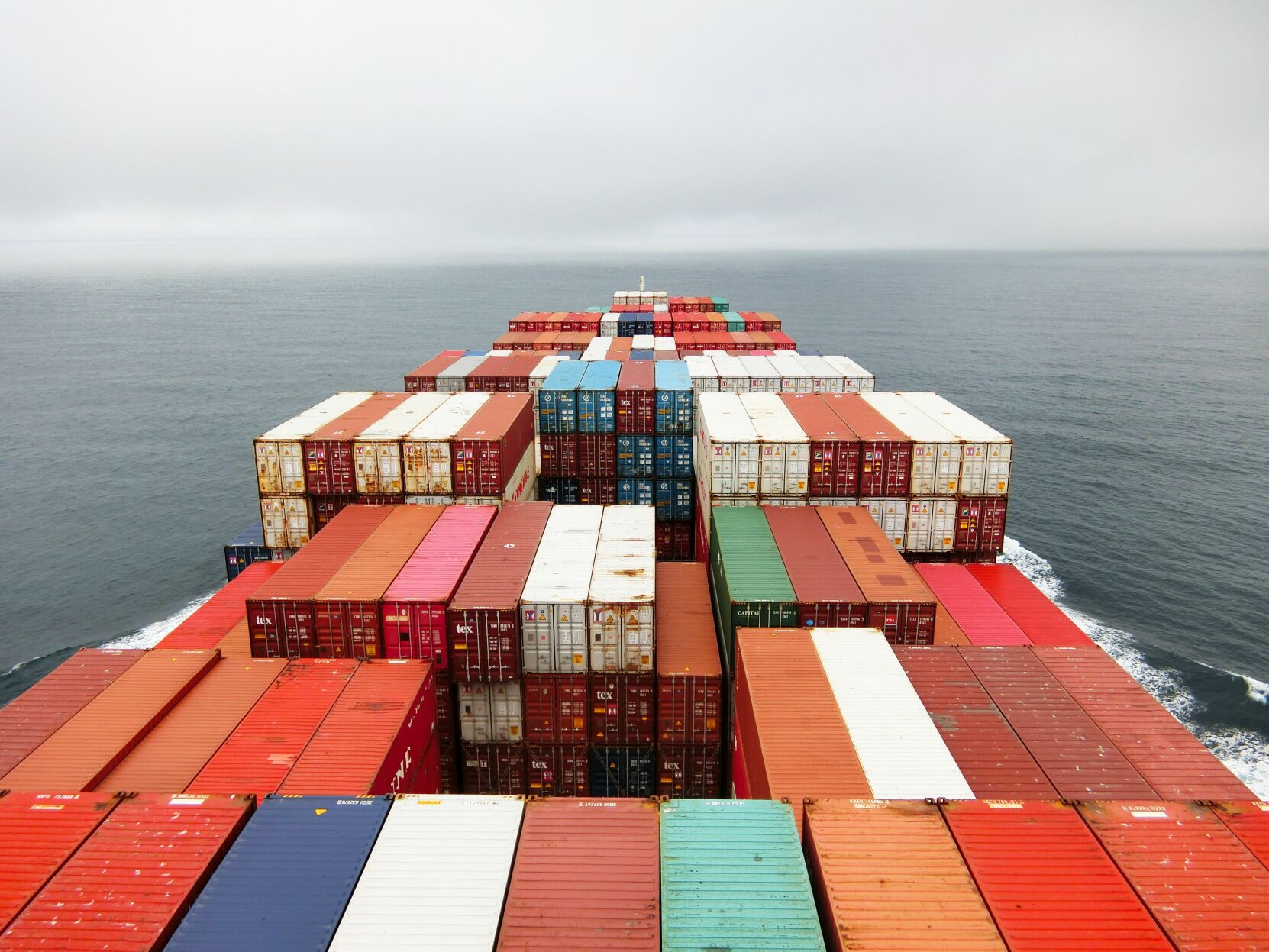Agri-Pulse Communications, the National Milk Producers Federation and the U.S. Dairy Export Council presented a webinar, Jan. 31, “Digging into the ag export supply chain crisis and how to fix it.”
The event featured two panels with experts in varying fields. The first panel featured “key players in a farm to fork supply chain” according to program facilitator Sara Wyant of Agri-Pulse. Moderator of this panel was Jamie Castaneda, executive vice president of policy development and strategy for the National Milk Producers Federation. On the panel was Mike Durkin, president and CEO of Leprino Foods Company; Andrew Hwang, manager of maritime business development and international marketing at the Port of Oakland; and Jonathan Eisen, director of the American Trucking Association’s intermodal motor carriers conference.
Wyant said there is no part of the transportation sector that has been spared from supply chain disruptions.
“Higher rates and shipping delays often hit farmers and food companies especially hard,” Wyant said. “A survey recently conducted by the Agricultural Transportation Coalition found that on average 22% of U.S. agriculture foreign sales could not be completed doing due to a long list of ocean carrier practices, including exorbitant freight rates and declined booking requests.”
In the survey, members, who include dozens of major farm and food companies, said they are losing customers in foreign markets because of the breakdowns.
For food
For Durkin, leading a privately held family business based in Denver, Colorado, they have faced issues with supplies at their nine plants across the United States and two more in other parts of the world. Leprino Foods is the single largest buyer of milk in the U.S., and the world’s largest seller and maker of mozzarella cheese, and one of the world’s largest sellers of whey products across the country.
“We export 26% of our solids in the United States,” he said. “Sixteen percent is actually the U.S. average out there in terms of what happens with the total milk solids in the country.”
In 2021, more than 90% of Leprino’s export orders were rolled or missed. Well over 100 orders were rolled 17 times.
“On a normal year, that would have been 10%,” Durkin said. “We had orders that were back ordered almost five months.”
At one point they had to airfreight product to some customers so they wouldn’t run out or be missing components to produce their own products.
“This is a big deal,” Durkin said. “It’s not just Leprino Food or the dairy industry—for agricultural products in general. So this issue has to be addressed.”
Durkin is pleased with the progress he’s seen in some shipping issues, but doesn’t see the issue going away any time soon.
“If you were to look at the last nine months, December was the worst month on record,” he said. “So we’re well into a year of this in terms of the shipping crisis and I know we had a lot of focus on imports. But exports are really where I think we need to put our attention today to be able to solve this problem.”
At the port
Hwang said administrators at the Port of Oakland, recognize the difficulties U.S. exporters are facing, particularly over the past year in getting products shipped out around the world.
“This difficulty is definitely creating long term market share loss for U.S. products,” he said. “And I think that’s very important for everyone to recognize is the potential permanent loss of market share around the world.”
At the port they’ve been working with their partners to try and overcome the situation, but have only had mild success.
“We’re actually very excited about the upcoming program that we are putting together in conjunction with local state and federal agencies,” Hwang said. “There are the programs here at the port that we’re also trying to implement to try and alleviate some of the situations for a couple years now.”
The port has a freight intelligent transportation system program, which will merge 15 technologies used to monitor and manage traffic in the port area. They’re also working on visibility tools to be able to give port users more information.
“Additionally here at the port we’re also looking to build for the future with the U.S. Army Corps of Engineers,” he said. “We are looking to widen our turning basin so we can handle the next generation of vessels. Our terminal partners have invested in larger cranes to also be able to handle those vessels as well.”
Also with growth comes responsibility, and Hwang said through public funding programs and partners they are looking to put in zero emission trucks in the port as well as hybrid terminal equipment, with the hope to reduce emissions by 95%.
“We’ve been working very diligently over the past few months to try and figure out several resolutions to these problems,” he said. “And slowly one by one we hope to be able to successfully tackle this problem.”
Gone trucking
Eisen said the trucking industry is about an $800 billion industry.
“We deliver about 74% of the freight in this country and employ about 8 million people across the country,” he said. “Obviously from our perspective, imports and exports are both equally important. We support both of them and need and encourage all of both things, need more imports and need more exports as well.”
Some of the challenges the trucking industry is facing aren’t exactly new, and their members’ issues aren’t brand new either. They’re being exacerbated by workforce challenges and with COVID.
“But these are things that have been in place for a while. We’ve been able to muddle through with them in place but now we are seeing them much more acutely,” Eisen said.
From a trucking perspective, Eisen looks at three key challenges—workforce, equipment and data sharing.
In the workforce segment there’s problems within trucking, with partners and warehouse distribution.
“Obviously, we’re seeing what’s happening with employment throughout the economy—that businesses in all sectors are having difficulty finding people right now,” he said. “That’s long been true for warehousing and distribution and trucking as well that that’s always been a challenge for all of us.”
Because of the difficulty finding employees it has many ramifications for trucking. For example, if trucks are waiting longer at the warehouses to get loaded or unloaded or if the warehouse is slowed because of trouble unloading containers—it creates a problem all through the process.
“And obviously the driver shortage has been discussed and I know you all have heard much about that over the years,” Eisen said. “That’s again a long term problem. One we’ve seen that’s been in place for many, many years, but is now exacerbated by the pandemic.”
In 2019, Eisen said the trucking industry was about 60,000 drivers short, now it’s climbed to about 80,000 short. That has ramifications throughout the supply chain.
“For the most part different sectors have different issues with the driver shortage. It certainly is more acute in in the long haul sector but that means that the warehouses next to the ports have trouble getting their product on to the next step,” he said. “So it all kind of has an accordion effect all through the process.”
Eisen also sees problems with equipment being the second key issue. Chassis provisioning has been a long-standing issue, with some ports doing traditionally better than others.
“But right now across the country at just about every port we’re working with—which is all the ports and at the inland intermodal facilities chassis are in very, very short supply that’s for a wide variety of reasons,” he said. “Yards are full of empties so we can’t always return empties and those empties are sitting in motor carrier yards on top of chassis. It’s things like that.”
There are also tariffs on imported Chinese chassis, making it pretty difficult to buy any chassis across the country, Eisen said.
The third key issue for Eisen is information and data sharing.
“Information is not shared well across the supply chain,” he said. “We don’t always get notice of (empties) well in advance it makes it much more difficult to manage our supply chain to manage equipment to manage people. And so hopefully improving that information sharing and data will be something that we’re we do significantly as we come out of this.”
Long term consequences
Castaneda asked the panel what are the “really long term consequences” if the breakdown in the chain isn’t fixed any time soon?
Durkin said his biggest concern from an international standpoint is customers look for reliability and consistency of supply. The inability to get products on a ship or into a port to customers is a concern of the long-term viability of the international market—not just for the dairy industry, but for agricultural products in general.
“We think we need creative thinking to be able to kind of solve this,” he said.
One of Durkin’s carriers said anywhere from 25 to 40% of bookings are ghost bookings, meaning they book multiple times because shippers don’t know if a shipment will get on a boat.
“It’s hard to coordinate,” he said. “Throw that on top of a chassis, equipment, labor shortage and if you have a quick notice to turn around.”
Durkin suggests focusing on the medium-term instead of long-term when it comes to challenges. At Leprino Foods, he suggests a fast lane approach, much like they have at Disney World, the FastPass. You pay to be at the front of the line.
Obviously we need to solve the equipment issue, but we also think about empties plus ghost bookings those are things that can be done immediately,” he said.
Hwang agrees. The ghost bookings, going forward, need to produce a new dynamic in regards how shoppers and carriers will contract in the future.
He sees the relationships between shippers and carriers in the future changing. First enforceable contracts need to happen.
“In the past contracts had penalties but none of them were ever enforceable just due to market conditions and market fears,” he said. “I think moving forward, carriers and shippers will be able to speak specifically to the needs of each party and to try and build a program that works for both parties.”
This could mean things like positioning equipment in very difficult areas and carriers getting import business into that area, so they can work to target the level of services they each need.
“And I think the last piece is that as opposed to looking at ocean shipping as a one piece of a supply chain, I think this will force parties to really view the all in costs of getting product from origin to destination,” Hwang said. “In the past there’s been a habit to break down the trucking leg, the ocean leg and now I think that what it’s forcing everyone to do is what is the all in cost.”
Hwang believes this will force shippers and carriers to evaluate costs as they move forward.
Kylene Scott can be reached at 620-227-1804 or [email protected].




